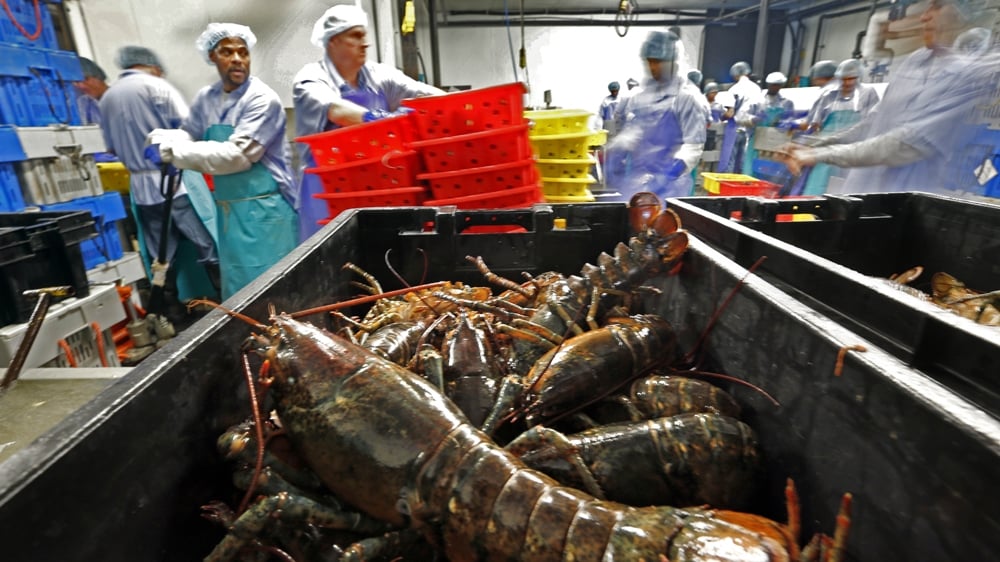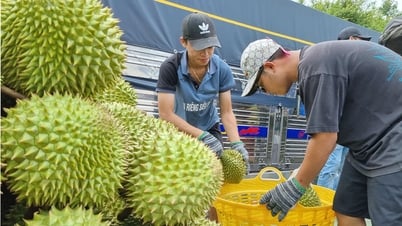Shrimp export value increased sharply
According to the Financial Times , for many years, China has remained the largest import market for Vietnamese lobster products. In the first two months of 2024, lobster exports to the Chinese market grew at an unprecedented rate, reaching nearly 29 million USD, 27 times higher than the same period last year.
Overall, lobster exports in the first two months of this year reached nearly 30 million USD, up 1,746% over the same period last year. Of which, green lobster exports (rock lobsters) accounted for more than 90% with 27.6 million USD, up 80 times, followed by spiny lobsters reaching 2.15 million USD, up 45 times over the same period.
According to data from the National Bureau of Statistics of China, the country's main supplier of spiny lobsters is currently New Zealand, accounting for nearly 40% of total imports. Mexico and the United States follow with market shares of 20% and 16%, respectively. Meanwhile, three member countries of the Association of Southeast Asian Nations (ASEAN), Indonesia, Thailand and Vietnam, are striving to increase their market share of lobsters in the country of a billion people.

For many years, China has remained the largest import market for Vietnamese lobster products. Illustration photo from the internet
According to the South China Morning Post (SCMP), nearly four years ago, the door for the three countries to bring lobsters into China was opened wider when Beijing banned lobster imports from Australia in response to Canberra’s call for an investigation into the origins of the coronavirus that caused the Covid-19 pandemic. Although relations between the two countries have improved since last year, the ban has not been lifted.
Sharing with Thanh Nien , a shrimp market expert of VASEP said that normally shrimp exports to China increase sharply in January because it coincides with the Lunar New Year, China's import demand is very large. But this year, the Lunar New Year falls in February and import-export enterprises of the two countries have nearly a week off, but the value of shrimp exports to China still maintains a high growth rate.
For the Chinese market, Ecuador is a shrimp supplier with a very large market share, but mainly raw shrimp. Meanwhile, Vietnamese shrimp products are very diverse, with the strength of processed products, and Chinese consumers will have many choices.
In addition, tensions from the Red Sea have pushed up shipping rates, making it difficult for Ecuadorian businesses to ship goods to China. Vietnamese businesses are also seeing difficulties in exporting shrimp to distant markets such as the EU, the US, etc. and are coming up with many solutions to focus on exploiting advantages and boosting shrimp exports to China.
The VASEP expert also commented that another "extremely optimistic" signal for the shrimp export industry to China is that Vietnamese shrimp products are currently priced higher than those of competitors.
This reflects that the Chinese market has recognized and evaluated the quality of Vietnamese shrimp as higher than that of goods from other countries. Chinese enterprises accept to buy shrimp at high prices from Vietnam and continuously increase import output.
"The Chinese market always has a very high demand for Vietnamese shrimp products, especially processed products. The evidence is that in 2023, China imported nearly 1 million tons of Vietnamese shrimp. If shrimp exporting enterprises focus on advertising, trade promotion, and boosting the export of deeply processed, high-value products, shrimp exports to China this year will grow strongly," according to VASEP experts.
The problem of increasing shrimp value in the world market
According to Industry and Trade magazine, many experts predict that Vietnam's shrimp exports will recover positively as global shrimp supply declines and demand gradually recovers, helping to boost export prices again.
The shrimp farming and harvesting cycle lasts an average of 4-6 months, so global shrimp supply is expected to tighten in the first half of this year, and is expected to gradually expand again in the second half of the year as global shrimp demand recovers.
In Vietnam, according to the Ministry of Agriculture and Rural Development, this year's weather forecast (dry and hot) is suitable for shrimp farming activities and shrimp supply will likely recover quickly, meeting processing needs well when export activities accelerate.
According to Tran Thuy Que Phuong, Chief of VASEP Office, Vietnam's shrimp exports this year will recover and grow by 10-15% in the context of the gradual economic recovery of key markets; businesses are promoting the production of value-added products and deep processing. In addition, the demand for products with protein sources from seafood is gradually replacing protein sources from animals, so in the coming time, seafood, especially shrimp, will have the opportunity to develop.
Therefore, to improve the competitiveness of Vietnamese shrimp, businesses need to find effective production methods to maintain business operations as well as increase the value of exported shrimp products on the market.
Regarding this, Mr. Le Van Quang - Chairman of the Board of Directors of Minh Phu Seafood Corporation said that Vietnam's raw shrimp is mainly produced on a small scale, raw materials for food and medicine production largely depend on imports, so production costs are currently about 30% higher than in India and Indonesia and many times higher than raw shrimp from Ecuador.
In addition, Vietnamese shrimp is still competing with other countries in the logistics segment. The route for shrimp products from India and Ecuador to the US and European markets is shorter than that of Vietnam. Combining these costs, Vietnamese shrimp must compete twice as much as other countries.
“Therefore, shrimp processing and exporting enterprises are required to invest in more advanced technology to create more deeply processed, high-value products to conquer the international market,” Mr. Le Van Quang emphasized.
Agreeing with this view, Mr. Ho Quoc Luc - General Director of Sao Ta Food Joint Stock Company said that in the field of shrimp processing, the whole world has only 6 countries, of which Vietnam and Thailand are the 2 leading countries in deep processing technology.
“Thanks to investment in modern technology, despite facing strong competitive pressure from cheap shrimp from Ecuador, India and Indonesia, Vietnamese shrimp can still stand firm, even occupying the largest market share in the international market compared to other countries. Therefore, to maintain its export position and cope with the difference in raw shrimp prices, the Vietnamese shrimp industry has promoted its strengths in deep processing and diversified deep-processed products to maintain market share,” Mr. Ho Quoc Luc shared.
Dao Vu (T/h)
Source



![[Photo] Scientific workshop "Building a socialist model associated with socialist people in Hai Phong city in the period of 2025-2030 and the following years"](https://vphoto.vietnam.vn/thumb/1200x675/vietnam/resource/IMAGE/2025/5/21/5098e06c813243b1bf5670f9dc20ad0a)
![[Photo] Prime Minister Pham Minh Chinh receives Rabbi Yoav Ben Tzur, Israeli Minister of Labor](https://vphoto.vietnam.vn/thumb/1200x675/vietnam/resource/IMAGE/2025/5/21/511bf6664512413ca5a275cbf3fb2f65)

![[Photo] Determining the pairs in the team semi-finals of the National Table Tennis Championship of Nhan Dan Newspaper](https://vphoto.vietnam.vn/thumb/1200x675/vietnam/resource/IMAGE/2025/5/21/eacbf7ae6a59497e9ae5da8e63d227bf)
![[Photo] Prime Minister Pham Minh Chinh attends the groundbreaking ceremony of Trump International Hung Yen Project](https://vphoto.vietnam.vn/thumb/1200x675/vietnam/resource/IMAGE/2025/5/21/ca84b87a74da4cddb2992a86966284cf)























































































Comment (0)